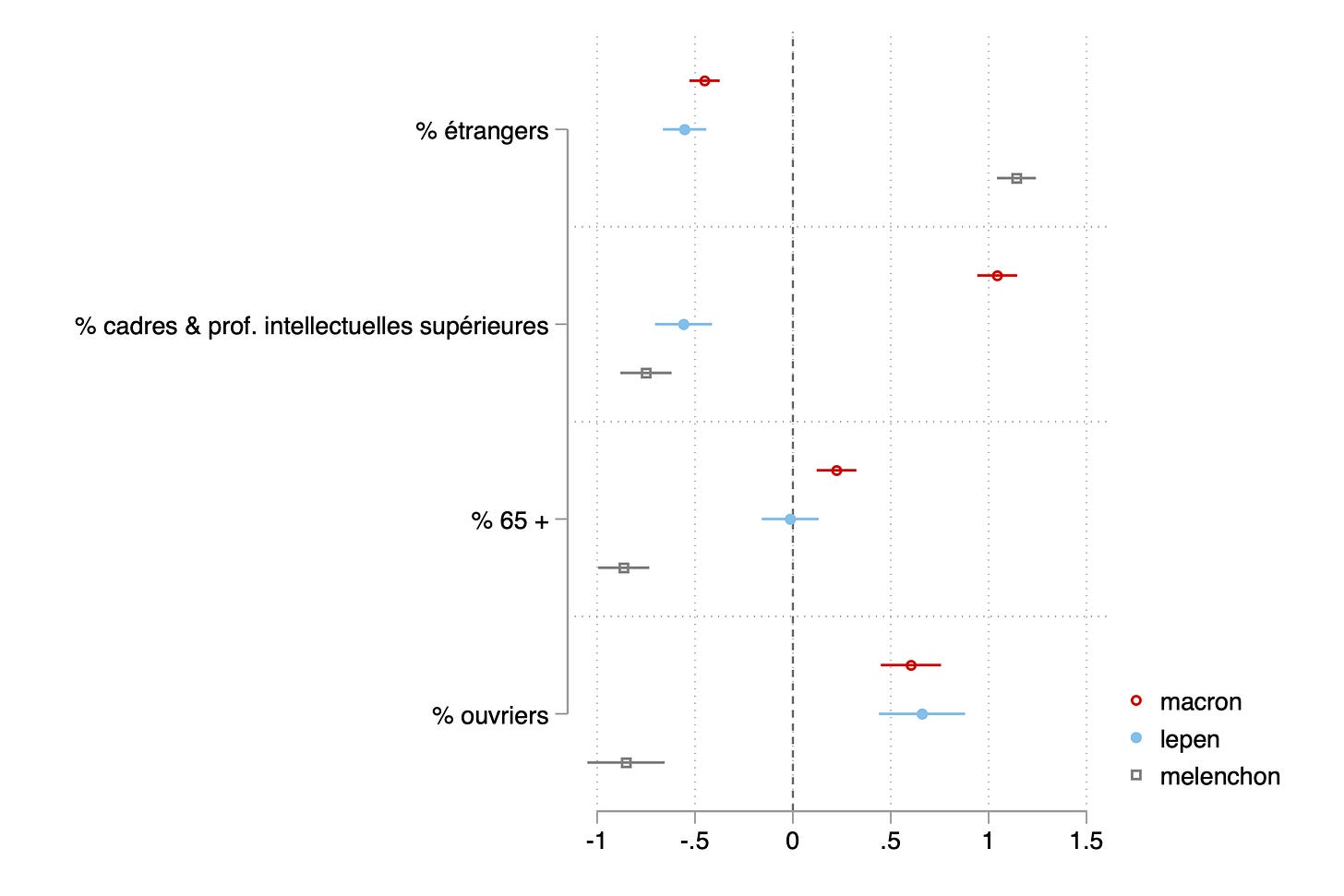#3 White working class areas for Le Pen, young ethnically diverse places for Mélenchon
Le Pen does better where there are more manual workers, Macron where there are more managers, Mélenchon in more diverse and younger places.
The first round of the French presidential election took place on 10 April. As predicted, Emmanuel Macron and Marine Le Pen came out on top, with 27.9% and 23.1% of the vote respectively, followed by Jean-Luc Mélenchon (22%). How can we explain the variation in their performance across French constituencies? In this post, I explore the determinants of the score of the top three candidates in the 539 electoral districts of metropolitan France using INSEE data collected during the last population census. These are aggregate data, so it may be perilous to extrapolate these data to individual behaviours, but they can give an idea of the type of places where each candidate did best.
A first interesting result is the relationship between the percentage of workers and the score of the different candidates in the first round. A clear positive relationship is visible between this percentage and the score of Marine Le Pen: on average, the candidate of the Rassemblement National does better in constituencies where the percentage of workers is higher, whereas this relationship is negative for Emmanuel Macron and Jean-Luc Mélenchon, at least if we look at simple bivariate relationships. In fact, the percentage of workers explains almost half of the variance in the Le Pen vote in French constituencies.

Another relationship that may be interesting to look at is that between the percentage of foreign citizens and these electoral shares. Insofar as Marine Le Pen and her party have traditionally made the limitation of immigration their main electoral theme, we can see that she does much better where there are fewer foreigners. It should be noted that this indicator only measures the proportion of individuals who do not have French nationality, and not the proportion of citizens with an immigrant background. However, we can assume strong correlation between these two indicators.
A notable phenomenon here is the strong relationship between this proportion of foreigners and the performance of Jean-Luc Mélenchon across French constituencies. For example, Mélenchon obtained more than half of the votes cast in some constituencies in Seine-St-Denis, a department with a high foreign and immigrant population.

Nevertheless, these relationships can be misleading if considered separately, as it is not known how these different variables are correlated. Figure 3 below represents the results of a linear regression combining different indicators to explain the score of the three candidates. In this way, it is possible to control for the impact (negative or positive) of each indicator in relation to the others. The analysis confirms the positive relationship of the percentage of foreigners with Mélenchon's score. We also observe a negative impact of the percentage of elderly people on his score, which tends to indicate that Mélenchon scores better where the population is more diverse and younger. In this respect, we can observe certain similarities with what we know about the election of Bernie Sanders in the United States.

There are more Emmanuel Macron voters where the proportion of older people is greater, where there are more managers and - interestingly - also where there are more manual workers once we control for other factors. It is interesting to note that the relationship between the proportion of workers and the share of the Mélenchon vote is negative, in contrast to what we observe for Marine Le Pen. This is a surprising result insofar as we often consider that Mélenchon and Le Pen are courting the same popular electorate, and that a non-negligible proportion of Mélenchon voters declare that they want to vote for Le Pen in the second round. Yet the constituencies where the two candidates obtain their highest scores are very different from a sociological point of view. Le Pen gets a higher score in areas dominated by the traditional white working class (especially in Northeast France), whereas Mélenchon does (much) better in more ethnically diverse, urban and young areas.

"Ouvriers"/Workers includes the service workers (like supermarket cashiers) or only the industrial/mining/construction workers?